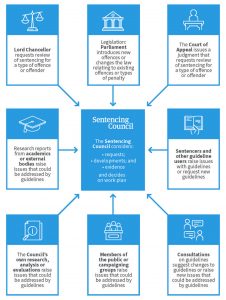Our criteria for developing or revising guidelines
The overarching aim of the Council in publishing guidelines is to promote a clear, fair and consistent approach to sentencing. In agreeing our work plan, the Council prioritises the publication of guidelines that will fulfil that aim and schedules guideline production and revision on the basis of one or more of the following factors:
- The Lord Chancellor or the Court of Appeal formally requests the review of sentencing for a particular offence, category of offence or category of offender and the Council considers that the production or revision of one or more guidelines is justified.
- Existing guideline(s) have become significantly out of date because of amendments to legislation or other external factors.
- New legislation or other external factors have created a demand for new guideline(s) among court users, and the Council considers that the necessary evidence is available to develop such guideline(s).
- There is evidence (from the Council’s own research or evaluations, interested groups or other sources) of issues relating to sentencing that the Council considers could be addressed by the development or revision of one or more guidelines. Such issues may include but are not limited to:
- evidence of inconsistency in the sentencing of an offence or group of offences;
- evidence of inequality in sentencing between different demographic groups;
- evidence of sentencing being too high or too low for a category of offence or category of offender; and/ or
- evidence relating to the effectiveness of different sentences.
A further factor that the Council will take into account in all cases is the resource available to produce or revise guidelines.
Important note: the Council is unlikely to undertake the development or revision of a guideline at a time when legislative changes that would affect that guideline are pending.

Minor changes to guidelines
As well as developing new guidelines or completely revising guidelines, sometimes the Council identifies issues that can be resolved without a full revision. These fall into two main categories:
1. Updates or correction of minor errors that can be made without consultation. These changes are made as and when needed and noted in a log. They include:
- clarifications or corrections to substantive errors or omissions that can be made in a way that gives effect to the Council’s original intention (which has already been consulted on)
- amendments made to reflect changes in legislation that will not have wider implications for the guideline(s)
- updates to information or terminology in a guideline that will not have wider implications for guidelines
Read the detailed policy for minor corrections.
2. Amendments to update or correct guidelines that require consultation. The Council will hold an annual miscellaneous consultation to cover:
- clarifications or corrections that were not covered by a previous consultation,
- amendments made to reflect changes to legislation where there are decisions to be made on how these will be applied to guidelines
- updates to information or terminology in guidelines that may have a wider impact
- interim guidance pending a revision of an existing guideline or development of a new guideline.
The changes covered in the annual miscellaneous consultation may relate to individual guidelines or apply across many guidelines
The broad timetable for the annual consultation (which may be subject to alteration) is:
- At any time – guideline users and other interested parties provide feedback to the Council on changes that may improve guidelines. The Council also monitors guidelines, case law and changes to legislation with a view to any changes that may be needed.
- May to July – the Council considers the issues and discusses how these can be addressed
- September to November – public consultation on the proposed changes
- December to January – the Council considers the responses to the consultation and makes changes to the proposals
- April – a response to the consultation is published and the changes come into effect